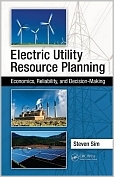| |||||
• polskie
• Zamów informacje o nowościach z wybranego tematu • kontakt |
ELECTRIC UTILITY RESOURCE PLANNING ECONOMICS RELIABILITYSIM S. / AND DECISION-MAKINGwydawnictwo: CRC PRESS, 2011, wydanie Icena netto: Electric Utility Resource Planning:Economics, Reliability, and Decision-MakingMost people—including many legislators, regulators, and other decision makers in the electric utility industry—have misconceptions about how electric utilities really "work" and plan for the future. This lack of understanding can lead to poorly informed decisions and policies that directly affect the choices utilities must make. Using easy-to-understand text and examples, Electric Utility Resource Planning: Economics, Reliability, and Decision-Making clarifies how utilities operate their systems and prepare for the future. This explanation will show readers that both expected and counterintuitive results can occur (i.e., conservation might result in higher air emissions, or lowering costs could lead to higher electric rates).Taking readers step by step through this process, the book (in the following order):
In addition, the author introduces four Fundamental Principles of Resource Planning that should guide utilities. He also offers opinions on how certain trends in utility regulation and legislation can hinder utility planners’ efforts to identify and select the best resources for the utility’s customers. With this book, author Dr. Steven Sim applies his experience and insights from more than two decades of resource planning for Florida Power and Light (FPL). As one of the largest utilities in the United States, FPL has faced a multitude of resource planning challenges, and Dr. Sim has performed and supervised thousands of analyses designed to meet these obstacles. He has also served as an FPL witness in regulatory hearings on a wide variety of topics, ranging from the economic implications of nuclear, conservation, coal, gas, and other resource options, to the non-economic impacts (air emissions, fuel usage, system reliability, etc.) they present. Table of Contents Introduction Why Write This Book? Who Is This Book Written For? An Overview of the Book Are We Keeping It Simple? A Few Words Regarding Assumptions Used in the Book A Couple of Disclaimers How Does an Electric Utility Actually "Work"? Two "Types" of Electric Utilities Whose Perspective Will Be Taken? What Aspects of an Electric Utility Will We Focus On? Types of Generating Units a Utility May Have How Does a Utility Decide Which Generating Units to Use? Let’s Create a Hypothetical Utility System Now Let’s Operate Our Hypothetical Utility System So What Have We Learned and Where Do We Go Next? Overview of Utility Resource Planning One More Assumption Regarding Our Hypothetical Utility System Three Questions Utility Resource Planning Must Always Answer Reliability Analysis: When Does a Utility Need to Add New Resources and What Is the Magnitude of Those Needed Resources? Resource Option Evaluation and Selection: What Is the Best Resource Option to Select for a Given Utility? Reliability Analyses for Our Utility System When Does Our Utility System Need New Resources? What Is the Magnitude of the New Resources Needed by Our Utility System? What Have We Learned and What Is Next? Resource Option Analyses for Our Utility System: Supply Options Types of Supply Options Under Consideration Preliminary Economic Screening Evaluation of the Supply Options Creating the Competing "Supply Only" Resource Plans Final (or System) Economic Evaluation of Supply Options Resource Option Analyses for Our Utility System: DSM Options Types of DSM Resource Options Under Consideration Preliminary Economic Screening Evaluation of DSM Options: Understanding the Cost-Effectiveness Screening Tests Preliminary Economic Screening Analyses of DSM Options: Results Creating the Competing "With DSM" Resource Plans Final (or System) Economic Analysis of DSM Options Final Resource Option Analyses for Our Utility System Economic Comparison of the Resource Plans Non-Economic Analyses of the Resource Plans Summary of Results from the Resource Option Analyses for Our Utility System Are We Done Yet? Other Factors That Can (and Will) Complicate Resource Planning Analyses Constraints on Solutions: Six Examples Examples of "Absolute" Constraints Examples of Legislative/Regulatory-Imposed Constraints Examples of Utility-Imposed Constraints What Are the Impacts of Addressing These Constraints? Final Thoughts (Including Some Opinions) A Summary of the Key Points We Have Learned About Utility Systems in General A Summary of the Key Lessons We Have Learned Regarding Utility Resource Planning A Few Opinions on Various Topics What Lies Ahead for Electric Utilities and Utility Resource Planning? Appendix A: Fundamental Principles of Electric Utility Resource Planning Appendix B: Glossary of Terms Appendix C: Mini-Lesson #1— Concepts of Revenue Requirements, Present Valuing of Costs and Discount Rates, Cumulative Present Value of Revenue Requirements, and Levelized Costs Appendix D: Mini-Lesson #2— Further Discussion of the Limitations of a Screening Curve Analytic Approach Appendix E: Mini-Lesson #3— Further Discussion of the RIM and TRC Preliminary Cost-Effectiveness Screening Tests for DSM Appendix F: Mini-Lesson #4— How Can a Resource Option Result in Lower Costs, but Increase Electric Rates? Appendix G: Mini-Lesson #5— How Can a Resource Option That Produces Emissions Lower a Utility’s Total System Emissions? ("The Taxi Cab Example") 332 pages, Hardcover Księgarnia nie działa. Nie odpowiadamy na pytania i nie realizujemy zamówien. Do odwolania !. |


